Fridays reviews of Kingdom of Heaven (out 5.6) made it clear almost no one agrees with me about Orlando Bloom’s Bailin or Ibelin filling the boots of a charismatic hero type. I know Bloom holds his own in this Ridley Scott film and then some, and I don’t need a large crowd agreeing with me on this, but I don’t seem to have any allies on this at all. Of all the stuff I’ve read since Friday, the meanest and funniest Orlando write-off has come from the Seattle Weekly‘s Tim Apppelo. “I know you like Kingdom of Heaven,,” he wrote the other day, “but thought you might be interested by my thesis that the main problem is a fine elf in a role that calls for a hero. As a war hero, Orlando Bloom reminds me of the nickname Truman Capote’s father gave him — Little Miss Mouse Fart.”
All Over Now
If you felt at least somewhat satisfied or soothed by the last two dud Star Wars films…
That is, if rock-like dialogue, mummified performances, crazy-beehive CG action scenes and a general skewing to a twelve year-old mentality hasn’t presented too much of a problem, Star Wars: Episode 3 — Revenge of the Sith probably won’t feel like too much of a burn.
For this sixth and final Star Wars feature, franchise creator and originator George Lucas hasn’t come up with any fresh surges or inspirations.

Hayden Christensen, Natalie Portman in Star Wars: Episode 3, Revenge of the Sith.
Here he is taking his Last Big Shot, and he just can’t break through the restraints of his conservative instincts and modest writing-and-directing abilities.
For a lot of people out there, this will be good enough (among them my former boss Kevin Smith, who raved after seeing it last week) and it’s okay with me. You know…whatever.
The fact of what Revenge of the Sith is….the big finale of a six-part sci-fi adventure saga that began 28 years ago…delivering the Big Payoff in fulfilling a tale foretold in The Empire Strikes and Return of the Jedi…depicting at long last the beat-by-beat of Annakin Skywalker’s final descent into the fires of anger and ego, leading to his transformation into the malevolent Darth Vader…can’t help but bring a certain satisfaction.
< ?php include ('/home/hollyw9/public_html/wired'); ?>
And it kind of does. Sort of. But oooh, man…the stuff you have to sit through. Roughly two hours and 15 minutes worth, not counting the end credits.
Which not that many people stayed for, by the way, at Thursday afternoon’s all-media screening at Manhattan’s Zeigfeld Theatre. (Which started 40 minutes late, by the way…incredible.) An awful lot of people got up and bolted as soon as the words “directed by George Lucas” hit the screen.
I wasn’t feeling much of a current in the room, frankly. There were a couple of woo-hoo! moments involving Yoda, and maybe one other. Every now and then an especially awful line was laughed at. The biggest hoot was in response to a line spoken at the very end by poor Jimmy Smits, about how he and his wife have always….whoops, forgot. No spoilers.

The immaculate CG delivers the usual eye-candy splendor, as usual, but c’mon…this is another woefully stiff, broomstick-up-the-butt sci-fi soap opera with the actors clearly suffering from having to mouth George Lucas’s hokey dialogue, and the only relief coming from the frantically busy visuals and the numerous action scenes.
These are more or less the same things that people were complaining about with The Phantom Menace and Attack of the Clones, right?
Sith is not a flat-out disappointment, but for anyone looking for that Big Uptick, for that sense of profound fulfillment and emotional finality with everything falling into place with and the meaning of it all….jeez, enough with the verbose pussyfooting. As the output of George Lucas goes, this is a somewhat grander, slightly more emotional, probably more necessary-to-see piece of shit.
The trades are already out with their reviews, and I’m presuming the dailies will run early-bird reviews (as they did with Phantom Menace and Clones), and David Poland went up last night with a reaction, so it seems fair to run something now as long as I don’t spoil.
Sith is critic-proof and certain to whup box-office ass, so what difference does it make what anyone says now or next week or the day before it opens (May 19th)?
The problem…the menace…is George Lucas, the big Star Wars Kahuna over the last 30 years who unfortunately insisted writing (with the help of polishers) and directing the three prequels.
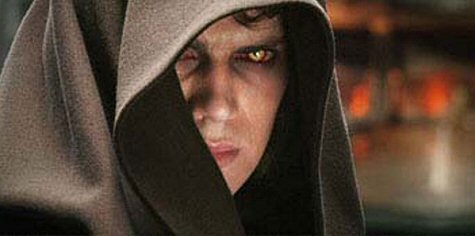
It wasn’t his determination to make the Star Wars play like Saturday-matinee serials that messed things up, but his inability to make the dialogue (even with alleged ghost-writer Tom Stoppard doing polishes) feel the least bit alive or angular in any way, or direct his actors in a way that doesn’t feel like showroom furniture arrangement.
Not to mention Lucas’s catastrophic decision to cast Jake Lloyd and Hayden Christensen as the two Annakin Skywalkers.
I’m not even sure the visuals are all that great, really. For all the ambitious design and detail and organic-looking textures, it basically belongs to the video-game world. All the fervor and inspiration that comes from having lots and lots of money to spend on complicated digital effects is relentlessly on view.
Remember those creaky old action sequences in Star Wars and The Empire Strikes Back when, say, three or four Empire star-fighters were chasing the Millenium Falcon here and there? Now we have scenes with hundreds of different vessels roaming around and blasting each other willy-nilly.
The idea seems to be that more is more. Over and over we’re shown this and that variation of a galactic traffic jam, and I don’t understand why Lucas and his ILM flunkies think that visual busy-ness and chaos in the skies is so cool.
Star Wars: Episode 3 — Revenge of the Sith is a prisoner- of-war movie. It’s about war (or, according to the narration crawl at the very beginning, “War!”) and the actors are prisoners in it. Jailed by George Lucas’s down-on-your-knees dreadful dialogue, and being well paid for their trouble.

Samuel L. Jackson has spoken in interviews about his character, Mace Windu, meeting his end in this film, so I don’t think this counts as a spoiler. I felt relief for the poor guy when he finally checked out. I thought to myself, “He’s free”…because he looked so miserable when alive.
There are two performances from Ian McDiarmid as Supreme Chancellor Palpatine — one very good, one excessive. He’s much better at being insinuating and diplomatic in the first half…before his character goes through a certain evolution and Lucas tells him to pull out the stops.
Natalie Portman, who seems to be suffering as much as Jackson, has a childbirth scene at the end. (C’mon…everyone knows she’s the mother of Luke and Leia.) I think it’s fair to call this scene the most unrealistic and unconvincing childbirth scene in cinema history.
There’s a scene in which a certain warrior gets his head cut off, but Lucas chickens out and doesn’t show the head rolling across the floor. I understand wanting a PG or PG-13 rating and all, but why write a beheading scene in the first place if you don’t intend to show it?
(On the other hand, Lucas was right not to show a scene in which a bunch of kids get light-sabered to death. This scene has been spoiled all over the place, by the way, so don’t yell at me.)
Just before the climactic battle between the Sith and the Jedi begins at the beginning of Act Three, there’s an order given to the Empire troops by a certain evildoer to commence “attack plan 66” (or something very close to that). I guess Lucas decided to leave off the third “6” because he didn’t want the allusion to seem too obvious.

Don’t get taken in by those clips and stills of a wookie army. Lucas has given Chewbacca the shaft in this film. He and his brethren are barely in it.
Some will be calling this the best of the prequels. Okay, maybe…but that’s not saying much.
There will be others calling this the most emotional of all six films. It is that, I suppose, but I didn’t feel all that much. And it’s not like I can’t feel anything from these films.
I don’t think the light-saber duels mean very much any more. They’re inventively staged here, but they’re just light-saber duels. They’ve burned themselves out.
Just because a franchise continues to sell tickets and merchandise doesn’t mean it’s not over. Just think…no more new Star Wars features from here on, and that’s probably for the best. It’s all going to TV next. Good move.
Stiff
“I think you can’t trust trailers any more. I think we’re all falling prey to the cutting, which can be very manipulative and often extremely false. You may remember that the Phantom Menace trailer made it look like it was on the level of the previous films, possibly even The Empire Strikes Back.
“I think Revenge of the Sith does look better than the last two pieces of shit Lucas put out but there is one warning sign that I picked up on: the dialogue scenes.
“Once again it looks boring and talky. And every line of dialogue is delivered with two people standing side by side. None of the dialogue is taking place during a real scene of any kind. Just two people standing around.
“This is exactly the horrible template Lucas used in the past two films. Some action scenes interspersed with a bunch of boring, lame after-school-special quality dialogue.
“Like you, I’m buying into the marketing and the hype but mostly the hope. I hope to God it doesn’t suck.” — Rich Elvers
Funny
Chicago Tribune writer Mark Caro ran the following interview piece about the link between Ben Affleck, Darth Vader and Revenge of the Sith in May 5. I’m rushing for a train so I can’t take the time to provide a link — I’ll put it in later today.
The article is called “Dark Lords: Anakin, Affleck”:
“For those who griped that the Star Wars movies have been too kiddie, here comes Star Wars: Episode III–Revenge of the Sith.
“The flick will be the first PG-13 movie of the series, and not only features Anakin Skywalker’s bloody mutilation, but also (SPOILER ALERT!) his taking a light saber to the junior Jedis in training. It happens off-camera, though.
“Chatting Wednesday at George Lucas’ scenic Skywalker Ranch north of San Francisco, where the movie was unveiled to journalists the previous night, producer Rick McCallum came up with an interesting analogy for Anakin’s actions.
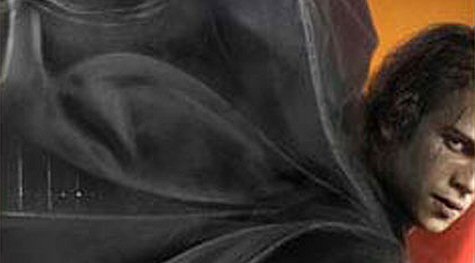
“Q. Do you think some audiences are going to have a problem with Anakin mowing down a bunch of kids?
“A: He has to kill those kids because that’s the only way he can get that power to be able to eventually work with Palpatine [the dark lord] to figure out a way to save his wife.
“He does it for kind of the right reasons, but if you put it in perspective, I always think of it as like watching Ben Affleck and Matt [Damon]. They wrote this thing [Good Will Hunting], they have this background together, they grew up together, they’re best friends, and they’re two totally different human beings right now. One is laid back, cool, does his work, works as best as he can, tries to be a good actor. The other one has taken the Dark Side, the dark route. It’s just amazing.
“Q: Because Ben Affleck has embraced the whole celebrity aspect?
“A: Yeah, the power thing.
“Q: He hasn’t killed little kids, though.
“A: No, but, can we take this out of [real] Ben? Take the hypothetical Ben in three or four years…career down the slide…and he’s given a choice to be able to resurrect his career, which is probably the most important thing to him, the fame aspect of it. Would he do anything? Who knows?”
What might have escaped you while watching Kung Fu Hustle is that about 35% of the lines are in one language, and the rest are in another. This is a uniquely Chinese problem. The actors talking to each other in a scene aren’t necessarily speaking the same language. Yet, much like Han Solo and Chewbacca, they communicate just fine. Is this found anywhere else in nature? And by the way, the movie is MUCH funnier if you know Cantonese. They have different archetypes. One last thought: I hope Stephen Chow doesn’t come to America and start sucking like John Woo.
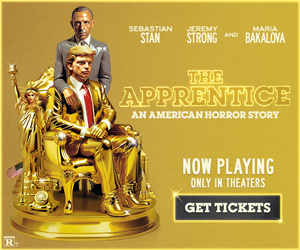
Rednecks
Crash (Lion’s Gate, 5.6) is worth your attention and respect. It’s one of those films that has the Big Picture on its mind. It isn’t preachy or assaultive (not to my mind anyway), but it damn sure swings for the fences.
Directed and co-written by Paul Haggis (who also adapted Million Dollar Baby), it’s a realistic, nicely sculpted, multi-character thing about racism. L.A. racism, to put a fine point on it, but folks in other regions will relate.
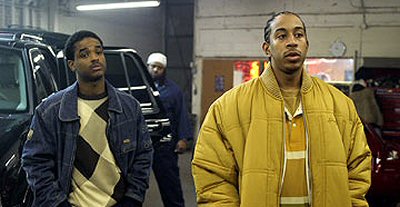
Larenz Tate, Chris “Ludacris” Bridges in Paul Haggis’s Crash.
It’s not a flip or cynical film, but mulling it over made me think of Randy Newman’s “Rednecks”. The chorus of this song and what Crash is saying fit together on a certain level.
Crash is one of those multi-character, criss-crossing fate movies that most of us associate with Robert Altman (Nashville, Short Cuts , Gosford Park) or Alan Rudolph (Choose Me, Welcome to L.A.). But it’s tighter and more disciplined that Altman’s usual stuff.
The closest comparison I can think of is Paul Thomas Anderson’s Magnolia, and I hope I haven’t scared anyone off by saying that.
< ?php include ('/home/hollyw9/public_html/wired'); ?>
Crash is also about rage and mistrust and bad tempers and fatigue, but it plays in a different key. The script, by Haggis and Bobby Moresco, is very intricate and well developed, and eventually (during the last third) it starts to feel like something really sharp and extra.
There are no weak or so-so performances in Crash, and it has some ace-level ones given by Don Cheadle, Thandie Newton, Terrence Howard, Ryan Phillipe (best thing he’s ever done), Larenz Tate, Chris “Ludacris” Bridges, Sandra Bullock and Matt Dillon.
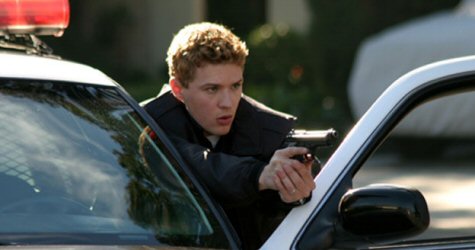
Ryan Phillipe as a conflicted police offer…his career best so far
One of the things I really liked about Haggis and Moresco’s script is that no character is seen as just one color or tendency. People are misread and mistaken for people they’re not all through it, and they all go through these little epihanies.
Matt Dillon’s character, an L.A. patrol cop whose racist attitudes are so belligerent and sulfuric he feels like a throwback to the L.A. Confidential era, is the most offensive, but even he turns out to have traces of heroism and compassion.
Crash is broad-minded enough to even acknowledge that some racial attitudes are semi-justified, or at least understandable.
New Yorker critic David Denby said that Crash “is the first movie I know of to acknowledge not only that the intolerant are also human but, further, that something like white fear of black street crime, or black fear of white cops, isn’t always irrational.”
Here’s an interesting Geoff Pevere interview with Haggis that will bring you up to snuff on the genesis of it.
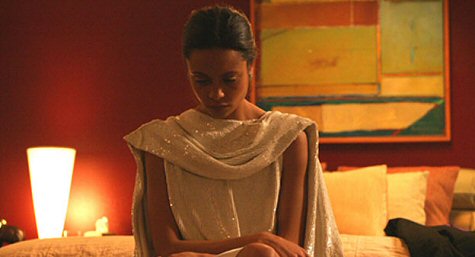
Thandie Newton, playing the wife of a successful Hollywood director (Terrence Howard) and grappling with rage and humiliation at the hands of a racist cop.
After you’ve seen a movie like Crash you know you’ve seen something. I’ve seen it twice now, and it got me thinking about who I really am, deep down, in terms of racial attitudes.
I’ve never thought of myself as a racist, but I’d be lying if I didn’t admit to being race-conscious. I’m merely saying that I notice stuff — traits, behavior, physical characteristics — that are specific to this or that racial-cultural crew. Is that so terrible? Talk to Paul Theroux about this.
Middle-aged white people from the Midwest, for example, not only look like a very culturally specific bunch but they behave and dress in a very specific oddball way. Their bodies are a bit softer and rounder, they have appalling taste in travel attire, and they always look slightly cowed.
It’s always a fascinating game for me in European airports to try and spot which travelers are French, English, American, German or Italian.
When you’re walking around the Dallas Ft. Worth airport there’s no missing the genetic differences between the natives (who come from Irish and Scottish ancestry) and the folks you’ll see in Los Angeles or San Francisco or Chicago.
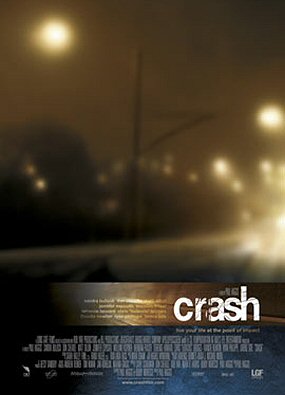
And anyone can spot in a second the multi-ethnic stew (old-school Italian, Irish, African-American, Caribbean, Middle Eastern, Russian, Indian, etc.) that is New York City when you’re walking through JFK or La Guardia.
I’m not being completely honest. Between the lines of my airport observations, occasional racist thoughts — call them flashes or spasms — pop through from time to time. I’m ashamed to admit it, but it’s true.
Jeez, I’ve written myself into a box here. I’m just trying to be frank and I’m sounding like Rod Steiger in In The Heat of the Night.
Maybe if I go even deeper I can dig myself out. This is a totally true story that happened to a friend in late ’94. In fact, now that I think about it, it could have been worked into Crash.
It involves alcoholism and reckless behavior, but the guy is over this problem now and I know he’s proud of that.
The guy is coming back from a party and half in the bag. Not blind drunk but definitely impaired. He’s on Sunset near Crescent Heights, and the car in front of him stops dead and he bangs into the car’s rear bumper. Nothing heavy, but there’s been some minor damage and insurance cards need to be exchanged.
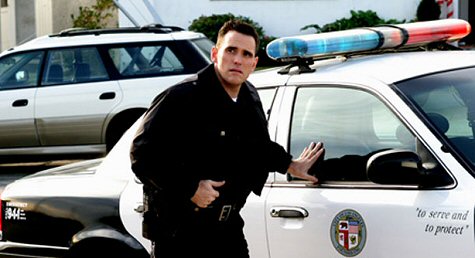
Matt Dillon.
Two African American women get out. He says “hey” in a relaxed way, and both parties agree to pull over to the side and sort things out, so the guy gets back in his car and then starts thinking, “Wait a minute.” He’s just been in another alcohol-related car accident (which the cops never heard about, luckily for him) and he doesn’t want to submit another report to the insurance company so soon after the last banger.
Being the mature, level-headed, shake-hands-with-reality type of dude he was at the time, the guy peels out and takes a sharp left and takes off down Sunset. I can lose these guys, he figures. But they peel right out and hit the gas and are right on his ass. He drives faster and faster…no change. He panics and starts to really break the traffic laws but he can’t shake them.
After about five minutes of this, he gives up and pulls over into an empty parking lot, and the women pull up next to him…freaked.
They’re hysterical with rage, outrage, fear and everything else. One of them pulls out her cell and calls the cops. The guy tells them he’s really sorry and doesn’t know why he gave into the idiotic impulse to run away and is trying to calm them down and talk things out, but the women are volcanoes and they want him nailed but good.
A cop car pulls up a few minutes later. The guy is cool with the fuzz, telling them he’s been a jerk and that he apologizes and wants to settle things, and the women are losing it — so angry and hysterical they’re close to crying, saying “he ran off!” and “you’ve got to arrest him!” and so on.
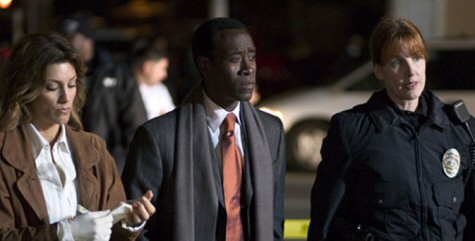
And guess what? The cops side with the guy. Because he’s calm and the woman are so over-the-top emotional and…
They make sure the women and the guy exchange phone numbers and whatnot, and then they tell the women to calm down and chill and they’ll take care of this guy. After the women are gone they tell my friend to lock his car and walk home because they can tell he’s had a few. And then one of them says, “Don’t ever say the L.A. police never cut anyone a break.”
This happened sometime around the O.J. Simpson trial — make of this what you will.
The guy is overwhelmed with affection for these two emissaries of the law. He can’t believe they let him walk. But they did because they didn’t like those two women. My friend rejoices at the racism behind this. He feels scared and shaken up, but strangely filled with hope. He loves L.A.!
We’re rednecks, we’re rednecks. We don’t know our ass from a hole in the ground. We’re rednecks, we’re rednecks. We’re keeping the niggahs down.
Surprise
I went to the House of Wax all-media on Monday night, more or less expecting to hate it. I thought I might get some material for a nice rip piece. But it’s not that bad for a throwaway slasher film. It’s reasonably decent — jolting, suspenseful, inventive.
The producer, Joel Silver, sometimes hires faceless MTV hotshots to direct his second-tier movies, and Jaume Collet-Serra, an MTV guy originally from Barcelona, clearly fits the bill, but he obviously knows what he’s doing and shows some real visual flair in the third act.
Collet-Serra could follow up on this and — who knows? — make himself into the next Antoine Fuqua.

It’s a lot wilder and bloodier than the 1953 House of Wax, a 3-D horror film with Vincent Price and Carolyn Jones. There are two significant links between them — i.e., the existence of a wax museum and a hard-core technique used to create life-like human sculptures.
House of Wax is a hodgepodge of every city slickers-visit-the-hinterlands shocker flick you’ve ever seen, from Psycho to The Texas Chainsaw Massacre to Deliverance to Last House on the Left, with a little taste of Brian DePalma’s Sisters.
Visually, Collet-Saura and Silver have really gone to town with the wax thing. The film is covered with the stuff…sprayed with it.
The guy who pops through is Chad Michael Murray (WB’s One Tree Hill). He plays the bad-ass brother of Elisha Cuthbert’s female lead — a guy who takes no lip and has aggression problems, etc. But it’s very satisfying when these anti-social impulses come into play against the villains of the piece, and you’re left thinking that it’s not so bad to have a bad-ass malcontent around when the going gets rough.
Wolf Creek, an Australian-made horror film I saw at last January’s Sundance Film Festival (and will apparently open later this year via Dimension) is still a better thing. Grittier, tastier, more original.

Chad Michael Murray, Elisha Cuthbert in House of Wax.
I also went to Wax because I wanted to enjoy Paris Hilton being killed. Isn’t that a pretty strong motivation all around? A Warner Bros. publicist was wearing one of those “See Paris Die” T-shirts at the door. And people in the audience did titter a bit when she got it. But not me.
I felt…could it be pity? Compassion? All I know is, she’s not that bad an actress — the word is inoffensive — and I don’t hate her any more. This sounds absurd, I realize, but her acting feels natural and unaffected. She doesn’t force it.
Theoretical question: if you throw a piece of sharp pipe at a person’s head (like a javelin or something), how likely is it that it will go right into their head and come out the other side? I’m not sure this would happen if you threw an arrow-shaped lead pipe at a really rotten, gutted pumpkin.
Complaint: Jared Padalecki, the guy who plays Cuthbert’s boyfriend, is way too big for her. He’s a foot and a half taller. Next to her he looks like a Wookie. [Note: Sorry for getting mis-identifying Padalecki earlier.]
Rising Intrigue
I am a Determined Detractor of George Lucas and the Star Wars prequels. I have said this over and over, but I am a hater because, a long time ago in a galaxy far, far way, I was a lover of The Empire Strikes Back, the best film in the series.
I feel Lucas has shamed the franchise over the last 22 years (since the release of Return of the Jedi) by not even trying to measure up to Empire.
And also because I hated Jake Lloyd in The Phantom Menace. And because those memories of Jar-Jar Binks will never go away. And because I despise Hayden Christensen’s Toronto accent and those awful vowel sounds. I remember an especially irritating delivery of a line (spoken to Natalie Portman) in Attack of the Clones: “I need haahllp!”

Hayden Christensen, Natalie Portman in Star Wars: Episode 3, Revenge of the Sith.
But I have to say (and I feel like a schmuck saying this because you can’t trust trailers) that the trailer or music video or whatever it is makes Star Wars: Episode 3, Revenge of the Sith (20th Century Fox, 5.19) look half decent.
I’m seeing Sith at Manhattan’s Ziegfeld on Thursday night. I have to admit that I’m feeling jazzed about this. Pretty much everyone is.
Sith is George’s last shot at restoring his reputation. If he fails with this final installment, his name as will be marginalized forever as a filmmaker who got it right with THX 1138, American Graffiti and Star Wars…and then went bad and corporate in his imaginings.
But if he succeeds…
Talk
There’s a commentary piece by Wendell Wittler in the current Newsweek listing the most memorable Star Wars moments.
His favorite Star Wars line is Harrison Ford’s “I know” to Carrie Fisher’s “I love you!” in Empire. Mine too.
My second favorite line is Ford saying to Fisher, “You like me because I’m a scoundrel.”

My third favorite line (and I realize this makes no sense at all, and I can’t even think up a good nonsensical reason right now to justify it right now) is also from The Empire Strikes Back and also spoken by Ford. It comes in the opening minutes. Han Solo is pissed at Chewbacca for letting go with one of his wookie laugh-growls at an inappropriate moment and he says…
“Laugh it up, fuzzball.” This is the dumbest thing I’ve ever copped to in this column, but I love this stupid-ass line.
I also love the sound of James Earl Jones’ electronically synthesized voice as he looks down at Solo’s carbon-frozen body and says, “Well, Kalrissian, did he survive?”
And like everyone else in the fanboy universe, I love the beautiful delivery that Jones gives to the immortal line, “No…I am your father.”
See what I mean? Empire lines, all.
Sez Who?
“When Attack of the Clones came out you posted what you thought were obvious spoilers, yet they were still spoilers. Can we have a spoiler warning this time, no matter how trivial, for the Last Lucas-directed Star Wars movie ever…please?
“Hayden’s Toronto accent doesn’t sound any better in the new trailer.
“Take this with a grain of salt, but my talent manager and an old buddy of mine from USC heard from some vp at FOX (my gut says it’s the same guy — my friend and manager don’t know each other) that the movie is terrible.
“The Fox guy also said that the people working on it couldn’t wait for it to be over.
“That said, neither friend buys this after seeing the new trailers.” — Name Withheld for Strategic Reasons
In a New York Times piece piece giving various sci-fi writers a forum to trash the Star Wars series, Henry Fountain writes, “As if hyperdrive rendered historical continuity irrelevant, the first Star Wars film was actually Episode IV, and the last is Episode III. In the eyes of nonfans, of course, it doesn’t really matter where one lands in the saga. After the second film (The Empire Strikes Back) the whole thing went downhill.” Well, yes …but Empire was the pinnacle of the series in the eyes of true fans…meaning those who got off the boat 22 years ago with the arrival of Return of the Jedi.
Of course, if you listen to Kevin Smith (yeah, my former boss), Revenge of the Sith is “fucking awesome…the Star Wars prequel the haters have been bitching for since The Phantom Menace came out. And if they don’t cop to that when they finally see it, they’re lying. As dark as Empire was, this movie goes a thousand times darker…[it’s] so satisfyingly tragic, you’ll think you’re watching Othello or Hamlet.” I’d really like to believe that, but how can I? How can anyone believe that George Lucas has had some kind of radical personality transplant…that the filmmaking instincts that made Jedi, Menace and Attack of the Clones such resounding groaners have suddenly been retired or banished? Nobody’s that covert and middle-aged guys don’t change their spots. But an army of journos will be seeing it this coming Thursday (5.5), so there will be plenty of opinions to sift through before long.

It’s easy to be skeptical about that Tom Cruise-Katie Holmes fluid exchange that’s supposedly happening, according to Cruise’s publicist (and sister) Lee Anne DeVette. My first instinct was to paraphrase Woody Allen and call it “a sham of a mockery of a mockery of a sham.” And I lurrrve Kyle Smith’s analysis of why it all seems like staged bullshit. Of course, people always hook up because they believe the other person will do something for their life or career, and Cruise and Holmes are naturally thinking along these lines. But I don’t believe it’s complete theatre. I don’t know what it is, exactly, but a person in a position to know once told me that the Tom-and-Nicole thing was fairly genuine…emotionally, anyway. You have to guard against being too cynical in this town, but I have to say I laughed out loud at that recent comment about that Cruise-Holmes appearance in Rome on Defamer, to wit: “Excuse us while we figure out a way to press our naked eyeballs onto the burners on the electric stove.”
There will be, it appears, at least a mild titillation factor for Stanley Kubrick fans in Brian Cook’s Color Me Kubrick. The story’s about a real-life guy named Alan Conway (John Malkovich) who went around London telling everyone he was Kubrick and getting away with it, to some extent…even though he didn’t look much like him. But the teaser on the film’s website (which has nothing on it except the teaser, which raises red flags right off the bat) feels a bit lame…it doesn’t say anything other than the fact that Conway pretended to be Kubrick, etc. And that Conway was gay. No twist, no angularity, no cushion shot of any kind. Something deep down is telling me the movie is underbaked. Maybe it’s the incest angle, since both Cook and screenwriter Anthony Frewin worked for Kubrick (Cook as an assistant director on Barry Lyndon and Eyes Wide Shut, Frewin as a personal assistant). The French trailer says it’ll open in France on 5.4.05, so I guess I’ll be able to take a train to Nice during the Cannes Film Festival and pay to see it in a regular theatre. If anyone in England has seen Kubrick or knows if it’ll be shown at a “market” screening on the rue d’Antibes, please let me know. I’d like these premonitions I’m feeling to be proved wrong.
Kevin Smith has seen Star Wars, Episode 3: Revenge of the Sith and LOVES IT. (he’s posted an early review, with spoilers, on his website.) Can this really be? After Willow, Howard the Duck, and the atrocious last two Star Wars flicks, can Lucas really be poised for redemption? Part of me wants to believe. (“Who’s the more foolish? The fool, or the fool who follows him?”) The rest of me remembers the unforgivable acting in “Attack of the Clones” and prepares for seppuku. I think fans should plan a massive Jonestown-like suicide party, just in case it does suck. Can you imagine the coverage of the line of stormtrooper corpses piled in front of the WRONG THEATER? Silent Bob’s review gives me hope, though. “You’re all clear, George! Now let’s blow this thing and go home.”

Kingdom‘s Lure
A few days ago a story about alleged right-wing disdain for Ridley Scott’s Kingdom of Heaven (20th Century Fox, 5.6) appeared in the London Times. **
The paper’s L.A. correspondent John Harlow reported that “Christian hostility” to the film (the righties don’t like it that some of the Crusaders are portrayed as selfish and “mean-spirited,” and they really don’t like it that Saladin, the Muslim military leader, is portrayed in “chivalrous” terms) may prove “damaging” at the box office.
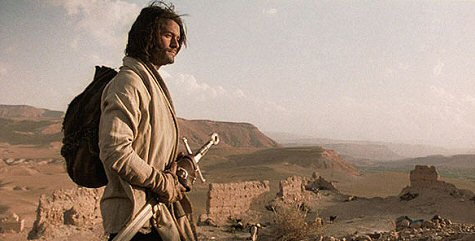
Orlando Bloom during relatively early scene in Ridley Scott’s Kingdom of Heaven.
Harlow wrote that “a spate of hostile reviews are due to appear in the increasingly influential religious press this week [that] will urge America’s 80 million born-again believers to avoid the $130 million film.”
Trust me — the righties are loony. One of the things I admire about Kingdom of Heaven is that it doesn’t draw crude stereotypes and is fairly even-handed in its portrayals of Christians and Muslims. Christian foam-at-the-mouth views about this are agenda-driven and skewed.
I wonder, in any case, if fans of The Passion of the Christ care all that much about the reputations of Christian Crusaders? As Revolution Pictures exec (and former 20th Century Fox distribution chief) Tom Sherak says, “That [Times] story is interesting but you know something? If people want to go to a movie, they’re going to go to it.”
And yet it’s significant, I feel, that the right-wing Christians vs. Kingdom of Heaven story is being seen as some kind of good thing. Controversy creates curiosity and leads to ticket sales, etc.
Others suspect it may be a case of too little, too late. The fact is that Ridley Scott’s big-budget epic — a beautifully made, epic-styled drama about the Muslim siege of the Christian-defended Jerusalem in the 12th Century — is looking to number-watchers and data crunchers like a passable performer, at best.
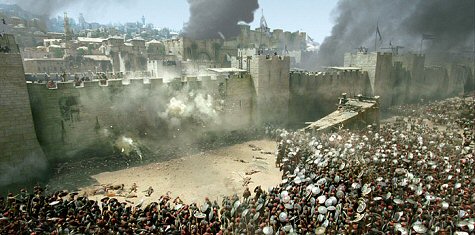
Before I get into this, let me say one thing: forget all this crap and just go. If you’re a fan of fine pageant-level filmmaking, Kingdom of Heaven is an essential. What do you care what others think?
That said, I think it’s fair to ask, as other journalists have done, whether Kingdom of Heaven will do better domestically than Hollywood’s last three historical battle epics — Alexander, King Arthur and The Alamo — which all turned out to be duds.
Especially considering that Heaven opens only a week from today (5.6) and research data suggests that average-viewer interest isn’t where it should be.
How many people really know what Kingdom of Heaven is about, given that the basic story comes off as a bit vague in the trailers?
How many people out there give that much of a toss about the Crusades, or have a clue what they were about?
How big of a mainstream draw is the film’s star, Orlando Bloom? He rules with 15 year-old girls but does he mean anything to the 25-and-over crowd?
Is Kingdom going to be a Troy-styled success, with modest returns in the U.S. but double-sized or better grosses overseas?

Bloom and Kingdom costar Eva Green.
Ask around and opinions vary. Some marketing executives are pessimistic or doubtful; others are uncertain or mildly positive.
A senior marketing executive based at a major studio said a couple of days ago that audience interest in Kingdom of Heaven is, according to tracking data, not that great.
“It’s hard to say what [Fox marketing] could be doing differently at this point,” he said. “But if I were handling this film, I would definitely be very nervous at this point. It’s a difficult story line to communicate…the biggest problem they have is communicating that. But it’s not over until it’s over.”
“I don’t have any delusion that this movie is going to be a colossal blockbuster, but you’ve got to watch the numbers every day,” a seasoned box-office analyst said Friday morning. “If the numbers don’t move after this weekend, they’re in trouble. If they do move, they’ll be fine.”
Two days ago an executive from a marketing boutique agency said, “What’s making me happy about Kingdom of Heaven is that it seems to have a solid older audience, which means it’s the kind of film that won’t drop a lot. People are going to go to it over a period of weeks, and interest among the four quadrants — young males and females and older males and older females — is averaging about 39, which is fairly good. So I don’t think you can count ’em out.”
“Right now, this movie is positioned somewhere in between where Gladiator, King Arthur, Troy and The Last Samurai were,” said Sherak. “This movie is really about Ridley Scott. The question is, will it have any heat going into the marketplace next week? It isn’t Gladiator, but right now the numbers are solid.”
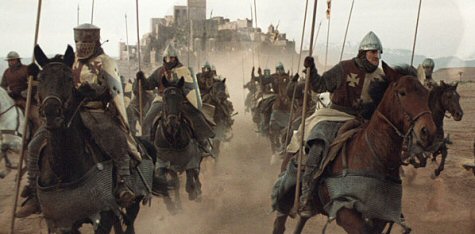
A veteran marketing executive disagrees. He says the film “is an ill-conceived project and it stars Orlando who? Think of Master and Commander without Russell Crowe. The title is lousy, the ending doesn’t work, the creative materials don’t tell you anything, they don’t have an advance-review campaign underway, it sounds like a three-snore picture and I’m telling you that the Fox people are worried sick.”
It was suggested during research on this story that I examine “comparables” to get an idea how Kingdom of Heaven is doing compared to the awareness and interest levels in Gladiator, King Arthur, Troy and The Last Samurai one week before their respective openings.
The figures come from a private industry tracking service called Cinesys, which provides its data to clients through National Research Group (NRG).
Based on telephone polling, it measures levels of unaided awareness (i.e., people knowing about a film without being told what its title is), general awareness, definite interest, and whether or not seeing this or that film is a first-choice selection.
As of today (Friday, 4.29), one week before opening, Kingdom of Heaven‘s unaided awareness is at 4%, general awareness is at 65 %, definite interest is at 40 % and 7% of the respondents called it a first-choice selection.
A marketing guy says, “One week from the opening and a 7% first choice for a movie of this cost and stature is toilet time, no matter how you look at it.”

One week before its 7.7.04 opening, King Arthur‘s unaided awareness was 4%, general awareness was at 76%, definite interest was at 48%, and 6% called it a first-choice selection. I don’t have the whole spreadsheet before me, but the IMDB says that King Arthur took in just over $51 million domestic.
The next three films had big stars in the lead role, so take these comparisons with a grain of salt.
One week before its 5.14.04 opening, Troy‘s unaided awareness was 17%, general awareness was 84%, definite interest was at 59%, and 18% called it a first-choice selection. Troy took in $133 million in the U.S., but the foreign totals were at least double that.
One week before its 5.5.00 opening, Gladiator‘s unaided awareness was 6%, general awareness was 75%, definite interest was 44%, and first choice was at 13%. It ended up with about $187 million domestic and a very healthy overseas gross.
One week before its 12.5.03 opening, The Last Samurai‘s unaided awareness levels were at 9%, general awareness was 81%, definite interest levels were at 42%, and first choice was at 6%. It was a groaner, but it wound up making $111 million domestic.
One way to build up interest in a high-profile film is to run advance rave reviews from major critics or get Time or Newsweek to run a feature story a week or two out. This hasn’t happened.
A friend tells me he heard a Kingdom of Heaven radio ad this morning that used a plug from CNN talk-show host Larry King. If that isn’t a sign of trouble, I don’t know what would be.
I disagree with the marketing veteran’s notion that Kingdom of Heaven ‘s ending doesn’t work.

I’ll repeat what I said in my 4.18 column: “Has there ever been a big expensive film about warring armies in which one side didn’t triumph absolutely? In which the loser wasn’t totally beaten down and slaughtered?
“I felt amazed and lifted up when this didn’t manifest…when life and sanity, in effect, is chosen over death and fanaticism.
And I think Orlando Bloom acquits himself in the lead role. Grimy and unshaven, he stands up and shoulders his responsibility like a man.
In the previous piece I called Heaven “a textural masterpiece” and “a big-canvas historical drama that dares to be different. It’s a complex and unusual thing… and what got me is the beauty of the brushstrokes. That and the avoidance of the usual usual.”
I’m seeing it again tonight and I`m looking very much forward to this. I only wish more people felt the same way.
Hold On…
There’s some kind of confusion about whether Focus on the Family film critic Bob Waliszewski is leading some kind of San Juan Hill charge against Kingdom of Heaven. It’s been suggested by Fox publicity sources that John Harlow of the London Times may not have it right, but I’m not sure either way because I can’t reach him.
In any case Fox sent me a statement from Bob Smithouser, editor of a site called Plugged In, which casts doubt upon the Waliszewski angle:
“Due to one journalist’s recent misrepresentation of Bob Waliszewski’s comments regarding the new Ridley Scott film Kingdom of Heaven, some people have been misled to believe that Focus on the Family is rallying forces against the movie. That’s simply not true.”
“Mr. Scott’s film about the Crusades actually deserves credit for carefully avoiding the wholesale vilification of either Christians or Muslims. While people of faith may object to individual moments, statements or characters in Kingdom of Heaven, the movie is not extreme or malicious, and we are content to let it succeed or fail on its own merits.”
This has no bearing on the marketing data aspects of my lead article about Kingdom of Heaven. I could rewrite the damn thing and just cut out the right-wing stuff at the beginning, but it’s easier to do it this way…for now.
Crop Calls
I absolutely swear to God there’s a great-looking Warner Home Video DVD of Elia Kazan’s A Face in the Crowd (1957) hitting stores a week from Tuesday (5.10).
It has terrific monochrome values, I mean…sharp and super-clarified and almost color-like in their fullness.
There’s only one problem: WHV technicians have cropped the image too tightly and presented it in what looks to me like a 1.85 (or 1.78) to 1 aspect ratio, with too many hairdos and foreheads sliced into for no reason.
A Face in the Crowd was photographed by Harry Stradling, who started out in the 1920s, shot A Streetcar Named Desire and ended his career working on a string of ’60s Barbra Streisand movies, including Funny Girl and Hello Dolly.
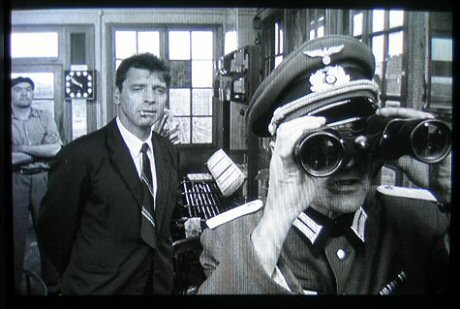 A scene from John Frankenheimer’s The Train, presented in more-or-less correct 1.66 to 1 aspect ratio on the MGM/UA Home Video DVD. Notice the sense of visual balance and breathing space around everyone’s head.
A scene from John Frankenheimer’s The Train, presented in more-or-less correct 1.66 to 1 aspect ratio on the MGM/UA Home Video DVD. Notice the sense of visual balance and breathing space around everyone’s head.
An early scene from Elia Kazan’s A Face in the Crowd, presented with an overly severe aspect ratio (seemingly 1.85 to 1) on an upcoming (5.10) Warner Home Video DVD. Notice the top of the frame scissoring into Andy Griffith’s pompadour.
Trust me when I say that old-fashioned guys like Stradling never used the top of the frame to crop into people’s heads, unless there was an emotional or compositional point to be made by doing so.
DVDs of almost all non-Scope movies shot in the 1950s and ’60s should be presented with 1.66 to 1 aspect ratios. I don’t care if the dp on a certain ’50s or ’60s film composed the shots with an expectation that 1.85 aperture plates would be used in theatres (because 1.85 was being used back then) — just use 1.66 and don’t think about it and don’t get creative and just shut up.
That is, except for special-dispensation films like Shane and Dr. Strangelove, which look much better when presented with a full-frame aspect ratio of 1.33 or 1.37 to 1.
MGM/UA Home Video’s DVD of John Frankenheimer’s The Train does it right. There’s a perfect sense of balance and proportion in every shot, and here are no scenes with anyone’s hair or forehead sliced into except when this kind of shot is appropriate and intended.
“Repeat after me, Kill Bill fans: Referentiality itself is not an intrinsic aesthetic value. Empty referentiality, going through the motions, doesn’t make a motion picture, give cinema the gift of sight….or insight.” So goes Ron Rosenbaum’s very astute piece about cheaply referential films in the 5.23.05 edition of the New York Observer. Quentin Tarantino’s martial-arts flick “was the perfect epitome of and metaphor for what I would like to call ‘The Cinema of Pretentious Stupidity,'” he continues. “The idea that ceaseless tedious references to obscure martial-arts movies known mainly by video-store geeks adds up to art. I’ve heard so many defenses of Kill Bill that depend on the apparently marvelous and unheard-of-before wonder of its referentiality. Dude, just because you make a reference — or many references — doesn’t make it meaningful or worth four hours of our time.”
Face-Off
On Tuesday afternon I saw a DVD of Paul Schrader’s Exorcist prequel flick, which has been titled as Dominion: A Prequel to The Exorcist. Warner Bros. will release it on May 20, and it’s about friggin’ time.
Do I have to recount the whole Exorcist mishegoss over the last two or three years? Are there people who haven’t read about Morgan Creek’s James Robinson shelving the Schrader because he felt it wasn’t scary or pea-soupy enough, and then hiring Renny Harlin to shoot a slicker, aimed-at-the-youth-market version, blah blah?
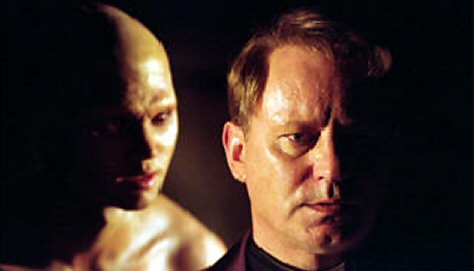
Stellan Skarsgard (r.), star of Dominion: A Prequel to The Exorcist, and costar Billy Crawford (l.) in burning demonic possession mode.
The story of the Schrader version, which was shot between late ’02 and early ’03, coming back from the dead and finding release is in this week’s Entertainment Weekly , in a “News and Notes” article by Missy Schwartz.
What I have to say may not muss your hair and knock you out of your chair, but it’s the truth. Schrader’s version is the better film.
< ?php include ('/home/hollyw9/public_html/wired'); ?>
By that I mean smarter and more grounded and being actually about something. It’s one of Schrader’s most thematically satisfying films, and there’s a caring and compassionate tone in the third act that feels unusual coming from the writer of Taxi Driver, Raging Bull, Hardcore and American Gigolo.
Okay, it has a couple of lumpy elements (one or two CG shots that don’t quite cut it, a lead female performance by Clara Bellar that feels stiff and awkward), but nothing to throw you off the rails.
The Schrader isn’t as juiced as the Harlin and it doesn’t have Izabella Scorupco (who has, for me, a close-to-breathtaking shower scene in the latter), but the Schrader is so much fuller and richer and more rooted than the Harlin it’s not even funny. It’s an actual movie, as opposed to a thrill-ride reel.
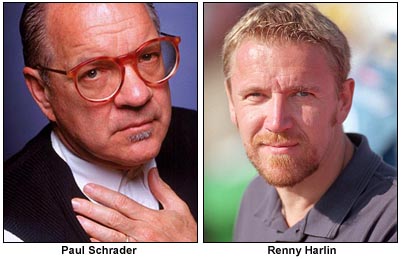
And the star of both films, Stellan Skarsgard, delivers a tenderer, more expressive performance in the Schrader version. His acting actually left me feeling emotional allegiance and admiration for a Catholic priest character, which I frankly haven’t gotten from any theatre-viewed film since…well, William Friedkin’s The Exorcist .
When I see a priest in a movie, I usually think “pederast alert!” or “okay, here comes the obligatory guy-who-doesn’t-get-it” or something along these lines. Schrader’s film manages to punch through all this and come up with a real hero in Skarsgard’s Lankaster Merrin, a Dutch priest who will eventually grow old and turn into Max von Sydow and meet up with Linda Blair and die of a heart attack in her refrigerated bedroom.
I saw the Schrader after watching Harlin’s Exorcist The Beginning, which came out last August and hit the DVD shelves on 3.1.05. I never bothered to see the Harlin, and I probably wouldn’t have even rented it on DVD if it hadn’t been for the arrival of the Schrader.
I have to say that I half-liked the Harlin…at first. Because it’s so beautifully photographed (by the great Vittorio Storaro, who also shot the Schrader version) and because it has that expensive texture and accelerated rhythm and feeling of sublime polish that big-budget films always have because people are somehow comforted by them (as I was myself, to a limited extent).
But it gradually gets worse and worse (i.e., stupider, tackier, more desperate) and by the time it’s over it’s hard not to hate it.
The Harlin is a better cheap-high movie than the Schrader, granted, but in what kind of perverse universe do we applaud cheap highs?

If you go to the Schrader saying, “Okay, I want to see some really cool stuff I can talk about with my friends later on,” you may be disappointed. In fact, I was a tiny bit disappointed…at first. But it gets better and better, and by the time it’s in the home stretch it’s paying off on a fairly profound level.
There are loads of similarities between the two films, and a few key differences.
The Schrader takes place in 1947. The Harlin happens in 1949. Don’t ask why. Even Schrader, whom I spoke to this morning, says he doesn’t have a clue.
Both films are about how Merrin re-connects with his belief in God and the righteous scheme of things after losing faith in just about everything after enduring a horrible Sophie’s Choice-like incident during World War II.
A German officer (played by the same actor in both films) is threatening to kill a large group of Dutch villagers if someone doesn’t confess to killing of a German soldier. He orders Merrin, the local Catholic priest, to select the guilty party…only one person at first, and then, after Merrin initially refuses, ten.
Schrader’s film begins with this episode, and is much more psychologically intriguing (by the virtue of being better written) than it is in the Harlin film, which flashes back to this episode in piecemeal fashion.
The Harlin film is totally shameless in having the German officer shoot an innocent little girl in the head. The Schrader isn’t any less traumatic than Harlin’s version, but it doesn’t feel like it’s exploiting a terrible situation.

Establishing title card in the Harlin version…

..and in the Schrader film.
The main story line of both films is about Merrin facing fundamental evil during an archeological dig in Kenya, where an ancient cathedral is being excavated…along with some long-buried demonic forces.
This unholy emergence not only forces Merrin to eventually confront a living devil, but to rediscover his lost faith…mainly, obviously, because it’s the only weapon that will work.
The Schrader is much more layered and ambivalent in some ways about the way native Africans regard the emissaries of Christianity. Some characters feel that Christianity is a bringer of a kind of plague. There is one male character, embittered about losing his son, who picks up a framed painting of Jesus Christ at one point and smashes it on a desk and then throws it to the ground.
And yet the conclusion of Schrader’s film is one of the most spiritually centered I’ve ever seen. Skarsgard’s Merrin is standing tall and firm and fully resolved about who he is and what he needs to do as a priest in order to fight evil. Merrin is also a priest again at the end of Harlin’s film, but the undercurrent isn’t as strong.
There’s a female doctor in the Schrader film played by Pellar. The doctor in the Harlin version is played by Scorupco, perhaps not in a fully believable way (female doctors are rarely this attractive, in my experience) but she’s still a better actress that Pellar. And her slightly-older-fashion-model, eastern-European quality (she’s Polish-born) is highly stimulating.
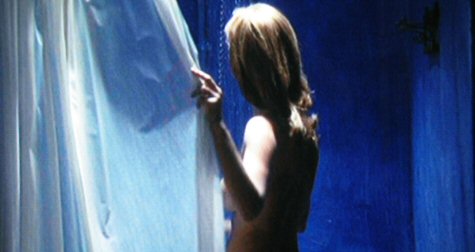
The great Izabella Scorupco in Harlin’s Exorcist: The Beginning
Scorupco’s breasts are (or should be) objects of sincere religious worship. They require abasement and groveling on the church floor. They made me feel born again, or do I mean newly born? Harlin deserves full credit for getting her shower scene just right.
Gabriel Mann plays a young and ardent Catholic priest in the Schrader version, but he is replaced by a somewhat less passionate, altogether less reliable priest, played by James D’Arcy in the Harlin.
There’s a local native guy named Chuma (played by Andrew French in both) who is Merrin’s closest and frankest ally. He seems more of a typical secondary character in the Harlin film, and a more intriguing and layered fellow in the Schrader version.
The Harlin film has a young African boy of about nine or ten falling victim to demonic possession. The possession host in the Schrader is a 20-something character named Cheche, played by pop star Billy Crawford. Sickly and spindly at first, his demonic inhabiting doesn’t turn him into a Linda Blair-type monster but an androgynous-like Hindu God figure with his physical maladies gone and his personality warped by ego, ferocity and manipulation.

Painting of Satan as it appears on buried cathedral walls in Harlin’s version.
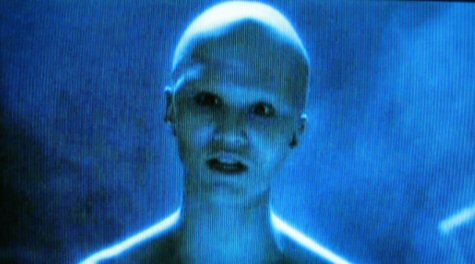
Billy Crawford in Satan mode in Schrader’s film.
This is far, far more interesting than the usual possessed by Beelzebub or the demon Pazuzu or Izusu crap in the Harlin version.
On the DVD I saw, the Schrader version looks like it was shot in 1.85 (i.e., standard Academy ratio) and the Harlin version is clearly framed in 2.35 to 1.
Schrader said that his version was actually shot in Univision, a system devised by Stroraro which has a wider aspect ratio than 1.85, and will be projected in theatres as Scope.
Schrader’s is more political than Harlin’s in the character of some British troops. They are portrayed as seriously belligerent pissers in his version but they barely figure in the Harlin film, except for the suicide of a certain officer character. (He shoots himself in the mouth in both films.)
Skarsgard seems to weigh a bit more in the Schrader version. He might be ten or fifteen pounds lighter in the Harlin film. His hair might be a touch blonder and he even seems a bit tanner.
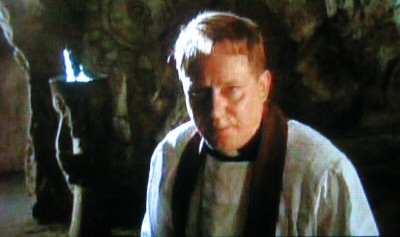
Slightly fuller-faced Sarsgard as he appears in Schrader’s film…
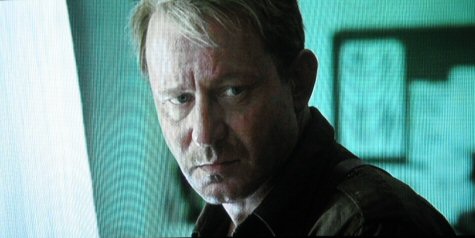
..and as he appears in Harlin’s.
The pacing of the Schrader film has been slowed down. “I wanted to make it feel like an older film,” Schrader told me, “rather than follow the typical pace of another jacked-up, pumped-up horror film.”
Schrader was contractually obliged to keep his yap shut last year before the Harlin film opened, but the gloves are off now.
“I saw in the Harlin film every bad idea that I had fought off,” Schrader told me. “Every bad Jim Robinson idea that I rejected, re-surfaced in the Harlin film, so I think the issue of true authorship is pretty clear.”
Schrader’s film cost about $30 million; the Harlin cost another $50 million. The total domestic gross for the Harlin as of last November was about $42 million. I don’t know what it’s made worldwide and on DVD, but probably another $50 or $60 million, at least, and maybe a lot more.
Would the Schrader film have earned as much? I doubt it. It’s not a mass-audience film. But when it’s over, you know you’ve had some nutrition. The Harlin makes you feel like you’ve just wolfed down a Big Mac and some fries.
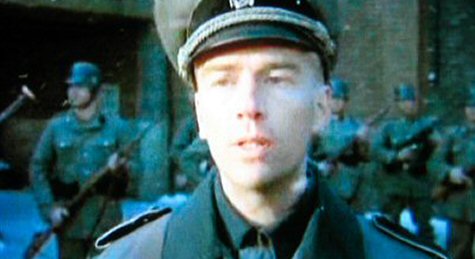
Dutch villager-killing German officer as he appears in Schrader’s film…

…and as he appears in Harlin’s version.
And of course, people like junk food. They know Big Macs are mostly chemicals and ground-up noses and ears and hooves and fatty sauces and most people don’t care. They just want the rush, and guys like James Robinson knows this.
By all means see the Schrader when it opens, but the more interesting thing to do is to watch these Exorcists prequels in tandem on DVD, like I did yesterday. Robinson and Warner Bros. should have put them both out simultaneously in theatres, a plan I suggested in this column on 8.11.04.
I quoted film critic and essayist David Thomson in that particular column. At one point he attempted a reading of why Schrader, who has never been and never will be a horror film kind of guy, took the deal to make the Exorcist prequel in the first place.
“There had to be an understanding on Paul’s point of view what a troubled route he was taking,” Thomson said. “He must have known what problems he was in, and I guess he took a gamble that they would argue it and change it a bit, and then let it go. I assumed he had made a bargain with himself that he could do [this film] to please himself and Morgan Creek at the same time.
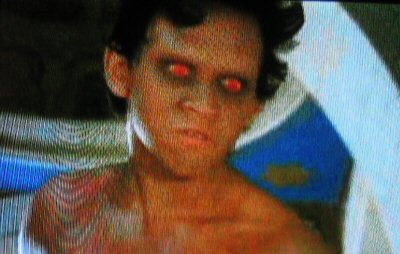
Billy Crawford in third-act scene from Schrader’s Dominion.
“I don’t know why they hired him,” Thomson continued. “It must have been clear in the script there were not great torrents of vomit.” Thomson saw a version of Schrader’s cut early on, and said in the piece that it “didn’t really seem like a continuation of the Exorcist franchise, and to that extent one could foresee trouble. Schrader had made a film about spiritual isolation…a study in a crisis of faith.”
Except it’s not a troubling experience to watch. Okay, the first part is, a tiny bit, but you get past that soon enough, and then it gathers force and it ends like gangbusters.
Schrader’s film may not work for your 15 year-old son or nephew, but unlike 97% of the horror films cranked out these days, it has an actual undercurrent. It’s a film about a spiritual tug-of-war by a guy who has written and directed more films about spiritual (and often volatile) conflict than anyone else I can think of.
If you don’t believe me or you’re not sure, click on Schrader’s IMDB page and read his credits.
Design for Flying
We’ve all seen that Man of Steel get-up that Brandon Routh will be wearing in Bryan Singer’s currently-rolling Superman Returns (Warner Bros., 6.30.06). And Movie City News recently ran a photo created by some fanboy site with a more routinely designed outfit, which is obviously meant as a suggestion.
The message, which I sense is probably endorsed by a good number of those who are jazzed about the Superman mystique and are looking forward to the film, is that Singer not do to Superman what Joel Schumacher did to Batman with the ass closeups and those pointy nipples on the chest plate.
The Singer suit uses burgundy instead of traditional fire-engine red for the shorts, cape and boots, and has Routh wearing hot go-go dancer bikini briefs instead of the standard gym shorts that Chris Reeve used to tool around in.
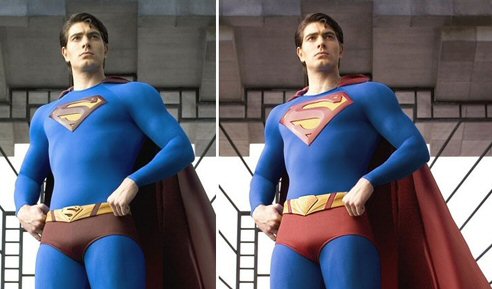
The fanboy designer, whomever he or she is, will eventually learn to live with the burgundy, but he/she obviously doesn’t like that bikini shit. The alternate design is pure D.C. Comics and straight out of the 1930s (or 1950s, a la George Reeve). The fanboys can see what’s going down and…well, draw your own inferences.
Of course, the boat has sailed and whatever kind of Superman Routh is going to be (and whatever his suit may end up conveying), it’s a done deal and the fanboys will have to make their calls as they see ’em.
Singer gave the X-men movies a certain dimension, I think, by subtly portraying the sense of social apartness that mutants feel in terms that any socially aware gay guy could relate to. I’m not saying this was overt, but it was there.
Remember that hilarious Roger Avary riff that Quentin Tarantino acted in Sleep With Me about the subtext of Tom Cruise’s Maverick character in Top Gun? “Go the gay way, go the gay way…you can ride my tail,” etc.?
I used this to mess with Jerry Bruckheimer and the late Don Simpson during a Crimson Tide junket interview about ten years ago. I told them, “Guys, you’re missing out on a whole marketing angle here. You should do an Advocate cover story and talk about the gay subtext in all your films, starting with the submarine in Crimson Tide.”
Monster Talk
“Your source wasn’t lying about Monster-in-Law being a hit waiting to happen.
“Unless the anti-Lopez sentiment keeps the crowds away, it should be a hit. I saw it this morning, and the audience went nuts for Jane Fonda’s wonderfully whacked-out performance as Viola Fields, a Barbara Walters type who loses her grip when she’s replaced on her talk show, ‘Personal Intimacy,’ by a ditzy hottie.
“The movie seemed to strike an especially strong chord with women who might have endured similar situations in their own lives.

“Still reeling from her abrupt fall from grace, Viola freaks when her son, a doctor (Michael Vartan, whose role is so perfunctory we never really even learn what his specialty is), proposes to Charlie (Lopez), a dogwalker/yoga instructor/aspiring designer, who also works as a temp in a doctor’s office.
“Viola throws the couple an engagement party and invites numerous celebrities and diplomats, just so she can introduce her future daughter-in-law with ‘this is Charlie — she’s a temp!’
“For those in the audience who have fantasized about seeing J.Lo humiliated, insulted and hassled, most of the rest of the film is going to be a delight. Wanda Sykes also got more than a few laughs as Viola’s put-upon assistant, who is caught in the crossfire between Viola and Charlie.
“Monster-in-Law is not a comedy classic, but it’s good fun and an excellent reminder of how sharp and funny Fonda can be.” — James Sanford.

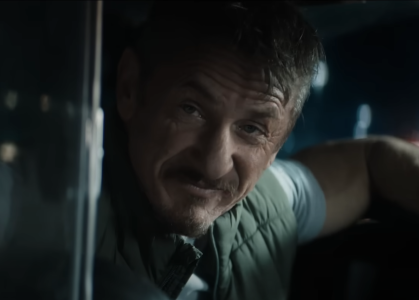 Really Nice Ride
Really Nice RideTo my great surprise and delight, Christy Hall‘s Daddio, which I was remiss in not seeing during last year’s Telluride...
More »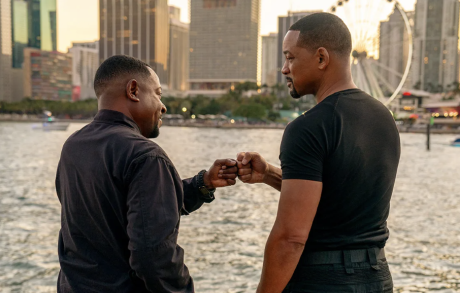 Live-Blogging “Bad Boys: Ride or Die”
Live-Blogging “Bad Boys: Ride or Die”7:45 pm: Okay, the initial light-hearted section (repartee, wedding, hospital, afterlife Joey Pants, healthy diet) was enjoyable, but Jesus, when...
More »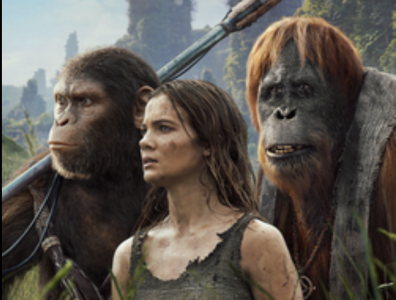 One of the Better Apes Franchise Flicks
One of the Better Apes Franchise FlicksIt took me a full month to see Wes Ball and Josh Friedman‘s Kingdom of the Planet of the Apes...
More »
- The Pull of Exceptional History
The Kamala surge is, I believe, mainly about two things — (a) people feeling lit up or joyful about being...
More » 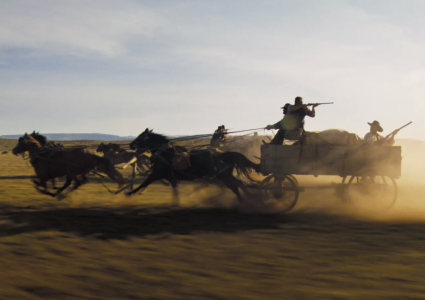 If I Was Costner, I’d Probably Throw In The Towel
If I Was Costner, I’d Probably Throw In The TowelUnless Part Two of Kevin Costner‘s Horizon (Warner Bros., 8.16) somehow improves upon the sluggish initial installment and delivers something...
More » Delicious, Demonic Otto Gross
Delicious, Demonic Otto GrossFor me, A Dangerous Method (2011) is David Cronenberg‘s tastiest and wickedest film — intense, sexually upfront and occasionally arousing...
More »


